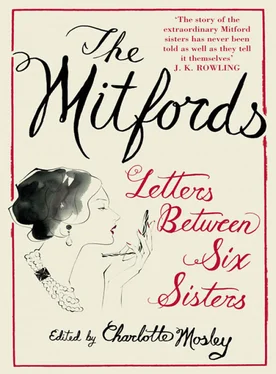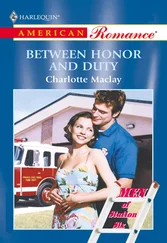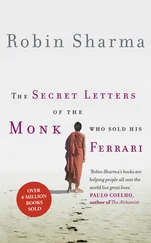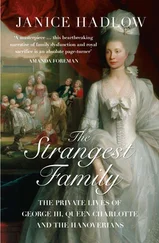Shortly before Diana’s engagement to Bryan in 1928, Pamela accepted a proposal of marriage from a neighbour of the Mitfords, Oliver Watney. The prospect of having two younger sisters married before she was may help to explain Nancy’s unwise decision to become unofficially engaged to Hamish St Clair-Erskine, a friend of Tom’s from Eton who was younger than her and homosexual. Her infatuation with Hamish dragged on for five unsatisfactory years, causing her a great deal of unhappiness. During this period she started to write her first articles for Vogue, and in 1930 was taken on as a regular contributor to cover social events for The Lady. This brought in a little pocket money, as did her first two novels, Highland Fling and Christmas Pudding, light satires on upper-class life that sketched out the world she would so successfully depict in her accomplished post-war novels.
Nancy used to say that the first three years of her life were perfect, ‘then a terrible thing happened, my sister Pamela was born’ which ‘threw me into a permanent rage for about 20 years’. Her affront at being supplanted in the nursery was compounded by an insensitive nanny who immediately shifted all her love and attention to the new baby. By the time Nancy was six and Pamela three, they might have overcome their differences and played together, had not Pamela contracted polio which affected her physical and mental development. She was in constant pain from an aching leg, and often tearful and sad. Her illness was doubtless a strain on Nancy: ‘you’ve got to be kind to Pam, she’s ill ’ , was dinned into her unceasingly. Instead of narrowing, as it normally would, the age gap between the two sisters widened. Pamela, who was the least able to defend herself, became Nancy’s scapegoat. She learnt to keep her head down and seems never to have shown any ill will towards her tormentor. She loved jokes as much as the rest of the family, and laughed about her own limitations, but she refused to retaliate or compete in the teasing. Her sisters nicknamed her ‘Woman’ because, like a symbolic character in a medieval Mystery Play, she epitomized the womanly virtues of simplicity and goodness. From her mother, she inherited dignity, common sense and the talent for making a comfortable home; from her father, a love of the countryside, where she was at her happiest. In 1925, when these letters begin, Pamela was a shy seventeen-year-old debutante, confiding to Diana her nervousness about going out into the world.
Unlike Nancy, who was a late developer and drew out her adolescence well into her twenties, Diana, by the time she was thirty, had been twice married, given birth to four sons and experienced the most eventful decade of her life. When these letters begin, she was a precocious fifteen-year-old, dreaming of independence. Her closest companion in the family, both in age and interests, was Tom, and when he was home for the holidays the two were inseparable. Diana admired her brother’s musical and intellectual talents and delighted in the company of his sophisticated friends. These glimpses of a world of art, music and intelligent conversation increased her yearning to escape the restrictive family atmosphere. The 1926 General Strike, sparked off by the grim working conditions in the coal mines, made a deep impression on her, kindling her social conscience and fostering a lifelong interest in politics. Whereas Nancy treated the national emergency as something of a joke and disguised herself as a tramp to frighten Pamela who was running a canteen serving food to strike-breaking lorry drivers, Diana felt the injustice of the miners’ situation acutely. Her interest in politics was also fuelled by visits to Chartwell, Winston Churchill’s family home in Kent. Churchill’s wife, Clementine, was a first cousin of Lord Redesdale, and two of the Churchill children, Diana and Randolph, were much the same age as Tom and Diana.
In 1927, Diana spent six months studying in Paris, where she said she learnt more than in six years of lessons at Asthall. For the first time in her life she was free of the strict chaperoning imposed by her parents and of having to jockey for position among her sisters. The painter Paul-César Helleu, a friend of Thomas Gibson-Bowles, was an important influence during her visit. He took her to the Louvre and Versailles, introduced her to his artist friends and admired her looks, making her aware for the first time of the effect of her exceptional beauty. When she returned to Swinbrook, Diana was more impatient than ever to get away from its schoolroom atmosphere. The following year, at the end of her first season, a proposal of marriage gave her the chance to escape. Bryan Guinness, the sensitive and diffident elder son of Lord Moyne and heir to a brewing fortune, fell deeply in love with her. A poet and novelist, Bryan was part of a group of Nancy’s Oxford friends that included Evelyn Waugh, John Betjeman, Roy Harrod, Harold Acton, James Lees-Milne, Henry Yorke and Robert Byron, young men whose interests represented everything that Diana aspired to. She and Bryan were married in January 1929 and divided their time between London and Biddesden, a fine eighteenth-century house in Wiltshire, where Diana was able to give free rein to her talent for decorating and entertaining. Unity, Jessica and Deborah often went to stay with the young couple and in 1930 Pamela settled in a nearby cottage to run the Biddesden farm. Nancy was a less frequent visitor. Caught up in her unhappy affair with Hamish and very short of money, it was galling to see Diana settled in a splendid house, surrounded by a loving husband and two healthy babies. However, the picture of happiness that Diana and Bryan presented was not as bright as it appeared. Although they were undoubtedly in love, there was a basic incompatibility between them that soon made itself felt. Increasingly, Bryan wanted to stay at home with only his family for company while Diana, who was eager to travel and fill her house with friends, found this domesticity all too reminiscent of the life she had so recently managed to escape.
In the spring of 1932, Diana sat next to Sir Oswald Mosley at a dinner party in London. The former Conservative MP and Labour Minister, whose New Party had been resoundingly defeated in the previous year’s general election, was preparing to break with parliamentary politics and launch the British Union of Fascists (BUF). Diana fell under the spell of this seasoned womanizer and compelling talker who seemed to her to have all the answers to Britain’s problems. In Mosley, she found the combination of a powerful man she could love and a cause to which she could dedicate herself, a pattern that Unity and Jessica – and to a lesser extent Nancy – were to conform to in their different ways. Mosley was married and made it clear that he would not leave his wife. Undeterred, and encouraged by Mosley, Diana decided to divorce Bryan in order to be available for her lover whenever he could spare the time from politics, family and the other women in his life. By throwing in her lot with Mosley, Diana was prepared to sacrifice her social position, distance herself from her beloved Tom, who disapproved of her leaving Bryan, alienate her parents – who refused to allow her two youngest sisters to visit her – and even risk losing her sons. She once wrote of her decision, ‘I probably ought to have behaved differently but I never regretted it’. Of the family, only Nancy supported Diana’s choice and became a regular visitor to the house in Eaton Square that Diana took after her divorce. It was no doubt easier for Nancy to be close to her sister when she was unpopular than when she was at the height of her success.
Unity was described by her mother as a sensitive, introverted little girl, who used to slip under the dining-room table if anything was said at meals that upset or embarrassed her. By the time she was eight, and had graduated to the schoolroom, she had become naughty and disruptive, her shyness concealed beneath a tough shell of sullen defiance. More solemn than her sisters, she lacked their quick wit and enjoyed practical rather than verbal jokes. In an effort to stand out, she behaved outrageously. When she was fourteen, partly because she was so difficult at home and partly because she wanted to go away, Lady Redesdale decided to make an exception among her daughters and sent Unity to boarding school. The three establishments she attended were no more successful at controlling her than her governesses had been and she was expelled from all of them. In 1932, she followed her older sisters and was launched into society: ‘a huge and a rather alarming debutante’, according to Jessica. Social life bored her and she had not grown out of the need to draw attention to herself. The only party she enjoyed was a Court ball, where she distinguished herself by stealing Buckingham Palace writing paper. In early 1933, to fill in the months before another Season, she enrolled at a London art school. Diana’s house in Eaton Square was forbidden to the two youngest Mitfords because of the scandal of her divorce and involvement with Mosley, but Unity, freed from parental supervision, was able to call on her sister whenever she liked. On one of her visits she met Mosley and became an instant convert to his ideas. The fascist cause had the attraction of being disapproved of by her parents, as well as providing her with the thrill of being connected to its charismatic leader. For Diana, who at the time was cut off from most of her family, Unity’s enthusiastic support was reassuring.
Читать дальше












